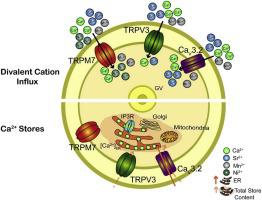当前位置:
X-MOL 学术
›
Cell Calcium
›
论文详情
Our official English website, www.x-mol.net, welcomes your
feedback! (Note: you will need to create a separate account there.)
Divalent cation influx and calcium homeostasis in germinal vesicle mouse oocytes.
Cell Calcium ( IF 4.3 ) Pub Date : 2020-02-12 , DOI: 10.1016/j.ceca.2020.102181 Goli Ardestani 1 , Aujan Mehregan 1 , Andrea Fleig 2 , F David Horgen 3 , Ingrid Carvacho 4 , Rafael A Fissore 1
Cell Calcium ( IF 4.3 ) Pub Date : 2020-02-12 , DOI: 10.1016/j.ceca.2020.102181 Goli Ardestani 1 , Aujan Mehregan 1 , Andrea Fleig 2 , F David Horgen 3 , Ingrid Carvacho 4 , Rafael A Fissore 1
Affiliation

|
Prior to maturation, mouse oocytes are arrested at the germinal vesicle (GV) stage during which they experience constitutive calcium (Ca2+) influx and spontaneous Ca2+ oscillations. The oscillations cease during maturation but Ca2+ influx continues, as the oocytes' internal stores attain maximal content at the culmination of maturation, the metaphase II stage. The identity of the channel(s) that underlie this Ca2+ influx has not been completely determined. GV and matured oocytes are known to express three Ca2+ channels, CaV3.2, TRPV3 and TRPM7, but females null for each of these channels are fertile and their oocytes display minor modifications in Ca2+ homeostasis, suggesting a complex regulation of Ca2+ influx. To define the contribution of these channels at the GV stage, we used different divalent cations, pharmacological inhibitors and genetic models. We found that the three channels are active at this stage. CaV3.2 and TRPM7 channels contributed the majority of Ca2+ influx, as inhibitors and oocytes from homologous knockout (KO) lines showed severely reduced Ca2+ entry. Sr2+ influx was promoted by CaV3.2 channels, as Sr2+ oscillations were negligible in CaV3.2-KO oocytes but robust in control and Trpv3-KO GV oocytes. Mn2+ entry relied on expression of CaV3.2 and TRPM7 channels, but Ni2+ entry depended on the latter. CaV3.2 and TRPV3 channels combined to fill the Ca2+ stores, although CaV3.2 was the most impactful. Studies with pharmacological inhibitors effectively blocked the influx of divalent cations, but displayed off-target effects, and occasionally agonist-like properties. In conclusion, GV oocytes express channels mediating Ca2+ and other divalent cation influx that are pivotal for fertilization and early development. These channels may serve as targets for intervention to improve the success of assisted reproductive technologies.
中文翻译:

生发囊泡小鼠卵母细胞中的二价阳离子流入和钙稳态。
在成熟之前,小鼠卵母细胞会停滞在生小泡(GV)阶段,在此期间它们会经历组成性钙(Ca2 +)流入和自发Ca2 +振荡。在成熟过程中振荡停止,但Ca2 +的流入仍在继续,因为卵母细胞的内部储存在成熟期(中期II期)达到最大含量。Ca 2+流入的基础通道的身份尚未完全确定。已知GV和成熟的卵母细胞表达三个Ca2 +通道,即CaV3.2,TRPV3和TRPM7,但雌性对于这些通道中的每一个都无效,并且它们的卵母细胞在Ca2 +稳态中表现出较小的修饰,表明对Ca2 +内流的调控很复杂。为了定义这些通道在GV阶段的贡献,我们使用了不同的二价阳离子,药理抑制剂和遗传模型。我们发现三个通道在此阶段处于活动状态。CaV3.2和TRPM7通道贡献了大部分Ca2 +流入,因为同源敲除(KO)系的抑制剂和卵母细胞显示Ca2 +进入严重减少。CaV3.2通道促进Sr2 +内流,因为CaV3.2-KO卵母细胞中Sr2 +振荡可忽略不计,但在对照和Trpv3-KO GV卵母细胞中则很强。Mn2 +的进入依赖于CaV3.2和TRPM7通道的表达,而Ni2 +的进入取决于后者。CaV3.2和TRPV3通道组合起来填补了Ca2 +存储,尽管CaV3.2的影响最大。用药理抑制剂进行的研究有效地阻止了二价阳离子的流入,但显示出脱靶效应,并偶有激动剂样性质。结论,GV卵母细胞表达介导Ca2 +和其他二价阳离子流入的通道,这些通道对于受精和早期发育至关重要。这些渠道可以作为干预的目标,以提高辅助生殖技术的成功率。
更新日期:2020-02-12
中文翻译:

生发囊泡小鼠卵母细胞中的二价阳离子流入和钙稳态。
在成熟之前,小鼠卵母细胞会停滞在生小泡(GV)阶段,在此期间它们会经历组成性钙(Ca2 +)流入和自发Ca2 +振荡。在成熟过程中振荡停止,但Ca2 +的流入仍在继续,因为卵母细胞的内部储存在成熟期(中期II期)达到最大含量。Ca 2+流入的基础通道的身份尚未完全确定。已知GV和成熟的卵母细胞表达三个Ca2 +通道,即CaV3.2,TRPV3和TRPM7,但雌性对于这些通道中的每一个都无效,并且它们的卵母细胞在Ca2 +稳态中表现出较小的修饰,表明对Ca2 +内流的调控很复杂。为了定义这些通道在GV阶段的贡献,我们使用了不同的二价阳离子,药理抑制剂和遗传模型。我们发现三个通道在此阶段处于活动状态。CaV3.2和TRPM7通道贡献了大部分Ca2 +流入,因为同源敲除(KO)系的抑制剂和卵母细胞显示Ca2 +进入严重减少。CaV3.2通道促进Sr2 +内流,因为CaV3.2-KO卵母细胞中Sr2 +振荡可忽略不计,但在对照和Trpv3-KO GV卵母细胞中则很强。Mn2 +的进入依赖于CaV3.2和TRPM7通道的表达,而Ni2 +的进入取决于后者。CaV3.2和TRPV3通道组合起来填补了Ca2 +存储,尽管CaV3.2的影响最大。用药理抑制剂进行的研究有效地阻止了二价阳离子的流入,但显示出脱靶效应,并偶有激动剂样性质。结论,GV卵母细胞表达介导Ca2 +和其他二价阳离子流入的通道,这些通道对于受精和早期发育至关重要。这些渠道可以作为干预的目标,以提高辅助生殖技术的成功率。











































 京公网安备 11010802027423号
京公网安备 11010802027423号